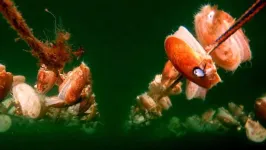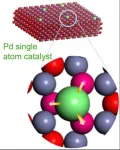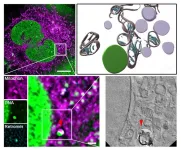(Press-News.org) A new study from the University of Maine’s Aquaculture Research Institute (ARI) and Darling Marine Center is helping to refine best practices for growing Atlantic sea scallops (Placopecten magellanicus), a species of increasing interest to Maine’s aquaculture sector.
Published in the academic journal Aquaculture, the research compares two scallop farming methods, ear-hanging and lantern net culture, over a complete grow-out cycle to determine which approach yields the best results for commercial growers. The study, led by UMaine postdoctoral researcher Christopher Noren, provides new insights into how each method influences scallop size and adductor muscle weight, a key factor in market value.
Evaluating Two Common Farming Methods
Maine’s scallop aquaculture industry is still in its early stages, and growers are looking for efficient ways to scale up production. Suspended culture is the most common approach, with farmers typically using multi-tiered lantern nets to grow scallops to a harvestable size. However, this method requires frequent maintenance to manage biofouling — an unwanted accumulation of microorganisms, plants and animals — and to optimize growth conditions.
Ear-hanging, a technique adapted from Japanese scallop farming, offers a potential alternative. This method involves drilling a small hole in the scallop’s shell and suspending it on a line, allowing for better water flow and potentially reducing maintenance needs.
To evaluate the effectiveness of each method, researchers partnered with two commercial scallop farms in Maine’s Penobscot Bay and Frenchman Bay. Over four years, they measured scallop growth and the weight of their adductor muscles, the primary product from scallops that are sold in U.S. seafood markets.
Findings to inform Maine’s aquaculture industry
The study found that scallops grown with ear-hanging culture had slightly larger shell heights, about 1–4% greater than those in lantern nets. More significantly, ear-hanging scallops had up to 12% more adductor muscle weight, which is the primary product sold in U.S. seafood markets and commands a higher price per pound when larger. This suggests a potential advantage for growers aiming to maximize profitability within that market.
“We wanted to provide growers with data they could actually use on the water,” said Christopher Noren, doctoral researcher at UMaine and lead author of the study. “By comparing these two methods across a full grow-out cycle, we were able to identify where the biological advantages lie and how they might translate to better yields and more efficient operations.”
The results also highlight the role of temperature in scallop growth. Ear-hanging scallops grew more quickly in optimal conditions, which are between 50 and 59 degrees Farhenheit, but were more affected by colder winter temperatures than those in lantern nets.
“These findings give scallop farmers a clearer picture of how different methods impact growth and harvest timing. Understanding the trade-offs between techniques will help inform decisions about production strategies.” says co-author Damian Brady, a professor of oceanography at UMaine.
Supporting a sustainable, domestic seafood supply
The U.S. imports the majority of its seafood, including scallops, from foreign markets. As interest in domestic scallop aquaculture grows, studies like this can help Maine farmers refine their operations and improve profitability.
“This research gives us real-world numbers to work with,” said Andrew Peters, owner of Vertical Bay LLC and co-author on the study. “Understanding how small changes in gear choice impact growth and market value helps us make smarter decisions as we scale up scallop farming in Maine.”
By identifying methods that balance growth efficiency with labor demands, UMaine researchers are contributing to the development of a sustainable scallop aquaculture industry in the Gulf of Maine.
END
UMaine research examines best methods for growing Atlantic sea scallops
2025-04-04
ELSE PRESS RELEASES FROM THIS DATE:
Medical cannabis could speed recovery, especially at community recovery homes
2025-04-04
A new pilot study from UBC Okanagan and Thompson Rivers University examined how medically supervised cannabis use in a residential recovery home may support people in treatment for substance use challenges.
Participants reported that cannabis helped them manage pain, anxiety, depression and sleep issues—key symptoms that can complicate recovery.
"Our findings suggest medical cannabis could play a meaningful role in reducing cravings and improving retention in recovery programs," says ...
Study assesses U.S. image amid weakening of democracy
2025-04-04
The erosion of democracy in the U.S. has been a topic of concern in recent years, especially after protesters stormed the U.S. Capitol on Jan. 6, 2021, in an attempt to block the certification of Joe Biden's election as president. Most of the academic studies on democratic backsliding, however, have focused on public opinion within the U.S. and have not looked at global public opinion.
How favorably others view the U.S. is part of the country's "soft power"—a term coined by Joseph Nye at Harvard University in the 1980s. It refers to a country's ability to influence other countries’ policy ...
Two scientific researchers to receive 2025 Ralph L. Sacco Scholarships for Brain Health
2025-04-04
DALLAS and MINNEAPOLIS, April 4, 2025 — The American Academy of Neurology and the American Heart Association have awarded the 2025 Ralph L. Sacco Scholarships for Brain Health to two researchers, Hortense Triniac, Ph.D., of Milwaukee and Katy Walsh, Ph.D., of Boston. Each will receive a $150,000 two-year scholarship to support continuing scientific research in brain health. This is the second year this scholarship has been awarded.
The Ralph L. Sacco Scholarships in Brain Health, also known as the Sacco Scholars program, are made possible by a generous bequest to the American Academy of Neurology, the world’s largest association of neurologists ...
Researchers improve chemical reaction that underpins products from foods to fuels
2025-04-04
CORVALLIS, Ore. – A chemical reaction that’s vital to a range of commercial and industrial goods may soon be initiated more effectively and less expensively thanks to a collaboration that included Oregon State University College of Engineering researchers.
The study, published in Nature, involves hydrogenation – adding the diatomic hydrogen molecule, H2, to other compounds.
“Hydrogenation is a critical and diverse reaction used to create food products, fuels, commodity chemicals and pharmaceuticals,” ...
Texas Tech to develop semiconductor power devices through $6 million grant
2025-04-04
Summary:
Texas Tech University’s Edward E. Whitacre Jr. College of Engineering has secured a $6 million U.S. Department of Defense grant to develop advanced semiconductor materials and devices, particularly for high-power electronics and optoelectronics. The project aims to enhance the performance of wide and ultra-wide bandgap semiconductors, leading to more reliable, high-performance electronics for military applications.
Why This Matters:
Technology Advancement: The research will improve the development of high-performance, high-power electronic devices critical for modern technologies.
Military/Defense Applications: The project targets key military systems, ...
Novel genomic screening tool enables precision reverse-engineering of genetic programming in cells
2025-04-04
RESEARCH SUMMARY
Novel genomic screening tool enables precision reverse-engineering of genetic programming in cells
Study Title: Transcription factor networks disproportionately enrich for heritability of blood cell phenotypes
Publication: Science
Corresponding Dana-Farber Cancer Institute authors: Alexis Caulier, MD, PhD, Vijay Sankaran, MD, PhD
Summary: Collaborative research led by investigators at Dana-Farber/Boston Children's Cancer and Blood Disorders Center defines a ...
Hot Schrödinger cat states created
2025-04-04
Quantum states can only be prepared and observed under highly controlled conditions. A research team from Innsbruck, Austria, has now succeeded in creating so-called hot Schrödinger cat states in a superconducting microwave resonator. The study, recently published in Science Advances, shows that quantum phenomena can also be observed and used in less perfect, warmer conditions.
Schrödinger cat states are a fascinating phenomenon in quantum physics in which a quantum object exists simultaneously in two different states. In Erwin Schrödinger's thought experiment, it is a cat that is alive ...
How cells repair their power plants
2025-04-04
Damage to the genetic material of mitochondria – the mitochondrial DNA or mtDNA for short – can lead to diseases such as Parkinson’s, Alzheimer’s, amyotrophic lateral sclerosis (ALS), cardiovascular diseases and type 2 diabetes. Such damage also speeds up the ageing process. However, the cells are normally capable of identifying such damage and reacting.
Scientists from University Hospital Düsseldorf and HHU have – in collaboration with the University of Cologne and the Center for Molecular Medicine Cologne (CMMC) – discovered a mechanism, which protects and repairs the mitochondria. The research ...
Oxygen is running low in inland waters—and humans are to blame
2025-04-04
Rivers, streams, lakes, and reservoirs aren’t just scenic parts of our landscape—they’re also vital engines for life on Earth. These inland waters ‘breathe’ oxygen, just like we do. But a new study led by Utrecht University researchers shows that we’ve been suffocating them during the last century, an era also known as the Anthropocene. The research, published today in Science Advances, reveals that the way oxygen is produced and used in inland waters has dramatically changed since 1900. ...
ACP’s Best Practice Advice addresses use of cannabis, cannabinoids for chronic noncancer pain
2025-04-04
NEW ORLEANS April 4, 2025 – The American College of Physicians (ACP) has issued Best Practice Advice for clinicians whose patients are considering or using cannabis or cannabinoids for management of chronic, noncancer pain. Cannabis or Cannabinoids for the Management of Chronic Noncancer Pain: Best Practice Advice From the American College of Physicians, was published today in Annals of Internal Medicine.
ACP’s Best Practice Advice paper is intended to inform clinicians about the evidence regarding the benefits and harms of cannabis or cannabinoids in the management of chronic noncancer pain and to provide advice for clinicians counseling patients seeking ...




